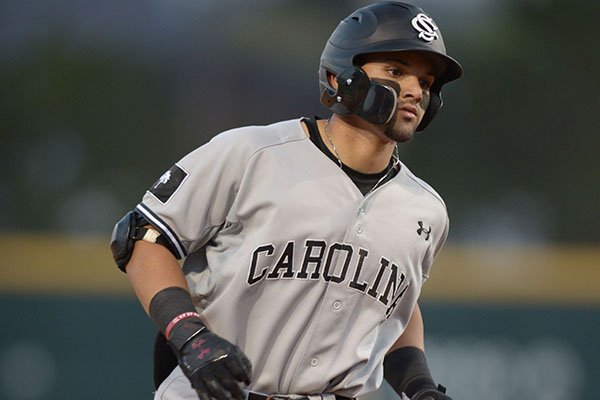
Carlos Cortes/Photo by Andy Shupe
Carlos Cortes
Position: 2B/OF B/T: L/S Age: 6/30/97 (21)
Acquired: 2018 Third Round Draft Pick from University of South Carolina
Previous Rank: 36
Stats (Brooklyn): .264/.338/.382, 5 2B, 2 3B, 4 HR, 24 RBI, SB
This will be the 150th year there was been professional baseball. Over that time, you have seen just about anything. There have been left-handed catchers, and with Pat Venditte, you have actually seen a pitcher throw right and left-handed in the same game. Rarely, if ever, have we seen a position player field play right and left-handed in the same game.
With Cortes, there’s a real possibility we may see that happen.
Cortes is naturally left-handed, but in an effort to make himself the best player possible, he learned how to throw right-handed. Perhaps one of the motivating factors for the decision is his size as Cortes is relatively diminutive standing at 5’7″. Looking across the majors, we mostly see players of that stature play at second base and not the outfield.
It’s not just his stature which is pushing Cortes towards second base. While you see players of his size usually play there, the bigger issue is his arm. While he may be naturally left-handed, his arm is still not good enough to play in the outfield everyday. For that matter, his right arm isn’t much stronger. When you factor in Cortes having slightly below average speed, if Cortes is going to be an everyday player, he’s going to have to be that at second base.
When looking at Cortes, he’s not going to make it to the majors because of his defense or because of how enticing it may be to see a Major League player throwing with both hands. No, if Cortes is going to make it to the Major Leagues, it is going to be because of his bat. That’s why the Mets drafted him in the 20th round of the 2016 draft, and it is why the team drafted him again in the third round in the past draft.
While the results, have not always been there, it is clear the Mets like Cortes’ bat.
Before going to the University of South Carolina, Cortes was regarded as one of the better prep bats in the draft. Instead of getting a jump start to his professional career, he opted to honor his collegiate commitment. When assessing Cortes going forward, it’s important to denote not just his solid collegiate statistics, but more importantly how he got to them.
In both his Freshman and Sophomore year, Cortes started the year slow only to have strong finishes. For example, last year, Cortes was hitting .180 over a month into the season. He would have a strong finish, and he would finish the year with a .265/.385/.500 slash line. This Sophomore season did see him make strides forward. He drew more walks thereby improving his OBP, and he would hit more homers. This is indicative of Cortes not only looking to hit for more power, but also his willingness to make adjustments to improve as a player.
We saw a glimpse of that during his time in Brooklyn. In his first month, he would struggle hitting .250/.323/.345. Much like in college, he shook off the slow start, and he had a terrific finish. Over his final 27 games, he would hit .294/.362/.441.
There were a few highlights from that final stretch of the season. Cortes would have four separate three-hit games. Over his final 27 games, he would have eight multi-hit games. In those games, you could see the type of hitter the Mets envisioned with then drafted Cortes. You could see the short, compact, and at times, contact oriented swing which could hit the balls to all fields. However, it should be noted Cortes has been working on being more than just a contact hitter.
Carlos Cortes (@loscortes_14) kept the party going with a bases clearing double. It's 5-0 @BKLYNJefes as we play in the 3rd inning. pic.twitter.com/5uhn4R6bgM
— Brooklyn Cyclones (@BKCyclones) August 11, 2018
In fact, some of his collegiate struggles could be attributed to his trying to create some upward tilt in his swing in an effort to hit for more power. There would be a glimpse of that power when he hit multiple home runs at MCU Park with the most impressive of those coming on August 9.
¡Adios pelota! Carlos Cortes (@loscortes_14 ) with a solo blast into the right field bleachers and the @BKLYNJefes lead 1-0 after four. #SomosJefes. #VamosJefes. pic.twitter.com/S5Sp80Y3jS
— Brooklyn Cyclones (@BKCyclones) August 10, 2018
With respect to that homer, it is important to note it is not only difficult to hit for homers in the New York-Penn League, but it is difficult to hit for homers at MCU Park. It’s even more difficult to hit for power to right field. Cortes did it on multiple occasions giving an indication as to what type of power he may develop as he matures and makes his way through the Mets farm system.
Going forward, Cortes is going to have to continue hitting this way, and he is going to have to continue to develop more power. If he does, he should be able to stick at second base. We should also remember he has the versatility to play the infield giving him a chance to make an impact as a utility player should be be blocked by another player.
Overall, we should be encouraged by how Cortes does all he can do to be an impactful baseball player. He makes adjustments not just year-to-year, but also in-season. He has even gone so far as to learn how to field and throw with a different hand. This is someone who wants to be a good baseball player, and he is willing to go that extra mile. It should have fans excited for what he can do in 2019 and beyond.
Editor’s Note: Jarred Kelenic, Justin Dunn, Luis Santana, Ross Adolph, Bobby Wahl, Adam Hill, Gerson Bautista and Felix Valerio were all in our original Top 50 before they were traded.
Previous Rankings:
50-46 Led by Michael Paez
45-41 Led by Ranfy Adon
40-36 Led by Anthony Dirocie
35-31 Led by Ryley Gilliam
30-26 Led by Chris Viall

